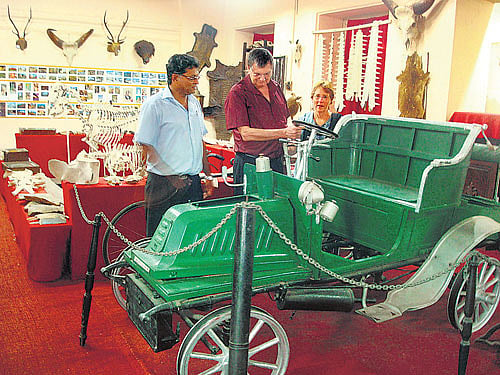
On hindsight, a car running at a speed of 19.5 km per hour, may be a poor cousin to modern day cars. But in the early part of the last century when the first car negotiated the streets of what was then Mangalore, it was a novelty and a star attraction. Prior to this, a horse-drawn coach was the chief means of transport for the upper echelons of society.
The French-made De Dion, an 8-10 HP single cylinder four-wheel, couch-type automobile was the first ever motor car to negotiate the narrow, winding and undulating roads of the coastal city of Mangalore, which was then a sleepy town, almost like an overgrown village.
It was brought from Paris by P F X Saldanha (1860-1938) of Highland Coffee Works, pioneer of the coffee curing industry in Mangalore. The car was shipped to the port town in October 1906. Its arrival created a sensation and crowds used to flock regularly to Mr Saldanha’s house to gaze at this four-wheeled miracle on wheels.
Driver hired on contract
As no drivers were available in Mangalore in those days, a driver called Luis Williams from what was then Bombay was hired under a contract written on a stamp paper, signed by the driver with three witnesses.
The stamp paper of the contract is still preserved by the descendants of P F X Saldanha. According to the details of the contract, signed on September 10, 1907, the driver Luis Williams alias Luis D’Souza is a 22 year old youth with Motor Vehicle Licence No 430 issued on June 13, 1907, by the Commissioner of Police, Bombay City. Perhaps there was no Transport authorities then. The contract period was for one year ending on August 31, 1908. His monthly salary was fixed at Rs 30 per month — quite a substantial amount compared with the wages and salaries of other occupations. The monthly salary was for days actually worked and if he absented himself he was liable to pay a fine of Rs 2 per day.
The conditions of the driver’s service included washing, cleaning, oiling and keeping the motor car in perfect order and condition. He was expected to drive carefully, not going too fast endangering the life of passengers, animals, or causing collusion. In case of accident due to his negligence he would be responsible for all the consequences.
The hours of his work were from 7 am to 7 pm with two hours lunch break. If his services were required beyond this time he would not be given any extra pay or allowance. If he quit before the contract period he was required to pay three months pay, Rs 90, as damages. His services could be dispensed with at any time by his employer, without giving notice.
Petrol ferried by boat
The car was used sparingly, for though there was no petrol rationing, petrol was a commodity for which there was no use and therefore not available. Petrol had to be ferried by boat all the way from Madras (now Chennai) to Bombay in five or ten gallon drums, under a special licence. Petrol was then brought to Mangalore from Bombay.
Mangalore was earlier a part of Madras province. In October 1907,when the Governor of Madras, Sir Arthur Lawley, visited Mangalore the De Dion was loaned to his two daughters, to motor up to Karkala, 33 miles from Mangalore, where the historic monolithic statue of Bahubali, revered by the Jains, stands. Sir Arthur had brought along his own magnificent, high-powered Daimler Sedan. But, it was not enough to accommodate his family and entourage. Saldanha gladly offered the use of the De Dion for the visiting party.
The De Dion was originally an open car, but in 1920, it was fitted with a hood over the front seat and the rear seat was converted into a dickey seat.
After the death of PFX Saldanha in 1935, the car fell into disuse. In 1946, a coffee planter, and a friend of the family, found the car lying unused in the shed. Finding that the engine was still in good condition, he asked for it and the retrieved engine was said to have been used a water pump. For ten years since then the engineless De Dion gathered dust in the shed.
Then, in 1956, Joseph G X Saldanha, son of the original owner, presented the car to the college museum. It now occupies a prominent place in the Aloyseum, the museum attached to St Aloysius College, located on the ground floor of the ‘Red Building’.
